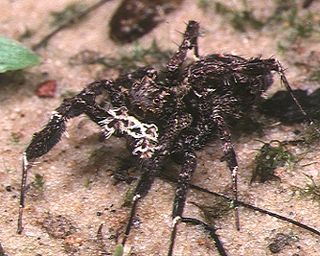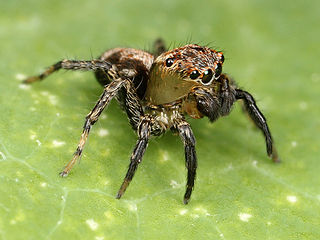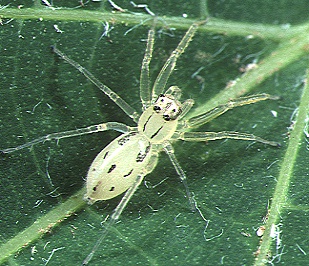Nebridia is a monotypic genus of Venezuelan jumping spiders containing the single species, Nebridia semicana. It was first described by Eugène Louis Simon in 1902, and is only found in Venezuela. It was briefly considered a synonym of Amphidraus, it was elevated to genus status in 2017.

Omoedus is a genus of jumping spiders.

Onomastus is a genus of Asian jumping spiders that was first described by Eugène Louis Simon in 1900. It is the only genus in the subfamily Onomastinae.
Thianitara is a genus of Southeast Asian jumping spiders that was first described by Eugène Louis Simon in 1903. As of August 2019 it contains only two species, found in Thailand, Indonesia, and Malaysia: T. spectrum and T. thailandica. It was briefly considered a junior synonym of Thiania until 2017, when it was revived by Jerzy Prószyński.
Wallaba is a monotypic genus of Guyanese jumping spiders containing the single species, Wallaba metallica. It was first described by Cândido Firmino de Mello-Leitão in 1940, and is found in Guyana. It was synonymized with Sidusa in 2015, but was revalidated by Jerzy Prószyński in 2017.

The Spartaeinae are a subfamily of the spider family Salticidae. The subfamily was established by Fred R. Wanless in 1984 to include the groups Boetheae, Cocaleae, Lineae, Codeteae and Cyrbeae, which in turn were defined by Eugène Simon.

Salticinae is a subfamily of jumping spiders. It includes over 90% of the known species of jumping spiders. The subfamily is divided into two unranked clades: Amycoida and Salticoida.

Lyssomaninae is a subfamily of jumping spiders. It includes four genera, three from the New World.

Amycini is a tribe of jumping spiders. It has been treated as the subfamily Amycinae.

Simonellini is a tribe of spiders belonging to the Amycoida clade of the subfamily Salticinae of the family Salticidae. The group has been treated at a variety of formal and informal ranks, with different circumscriptions, including as the subfamilies Synemosyninae and Simonellinae. Its species mimic ants and beetles.
Nepalicius is a genus of spiders in the family Salticidae. It was first described in 2016 by Prószyński. As of 2017, it contains 3 species.
Okinawicius is a genus of spiders in the family Salticidae. It was first described in 2016 by Prószyński. As of 2017, it contains 9 species.
Nandicius is a genus of spiders in the family Salticidae. It was first described in 2016 by Jerzy Prószyński. As of 2017, it contains 7 Asian species.
Rudakius is a genus of spiders in the family Salticidae. It was first described in 2016 by Prószyński. As of 2017, it contains 7 species.

Orienticius is a genus of spiders in the family Salticidae. It was first described in 2016 by Prószyński. As of 2017, it contains 2 species.
Junxattus is a monotypic genus of southeast Asian jumping spiders native to Sumatra. It contains the single species, Junxattus daiqini, first described by Jerzy Prószyński and Christa Deeleman-Reinhold in 2012. The genus was placed in the subfamily Euophryinae, the equivalent of the tribe Euophryini.
Padillothorax is a genus of southeastern Asian jumping spiders first described by Eugène Simon in 1901. As of April 2019 it contains only two species.

Asemoneinae is a subfamily of jumping spiders. It was created in 2015 by Wayne Maddison. Most species are found in Africa or Asia. The subfamily initially had five genera, but Hindumanes was later transferred to the subfamily Lyssomaninae.

Hisponinae is a subfamily of jumping spiders. The subfamily has six known extant genera and three extinct genera.

Amycoida is an unranked clade of the jumping spider family Salticidae. It is the smaller and less widespread of the two subdivisions of the "typical" jumping spiders, occurring mainly in the New World, particularly the Amazon basin. Its sister clade is the Salticoida.










